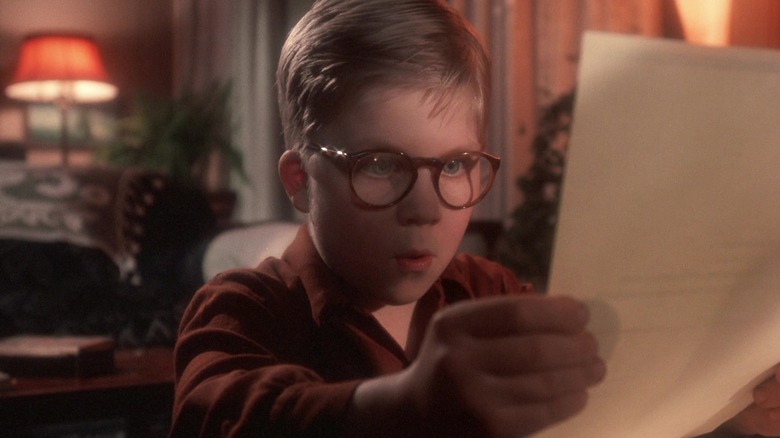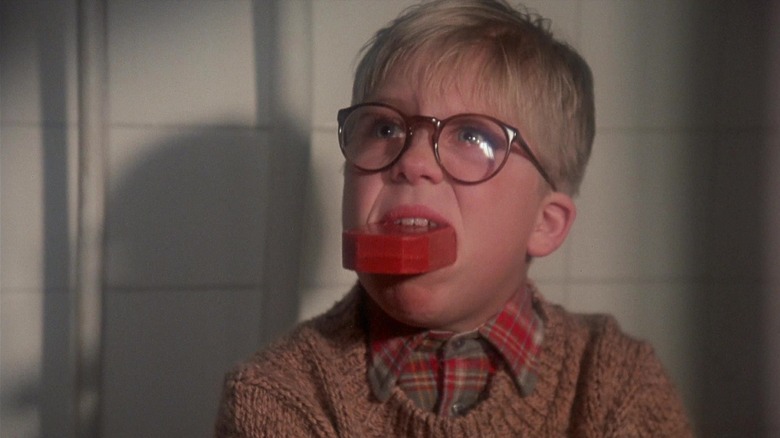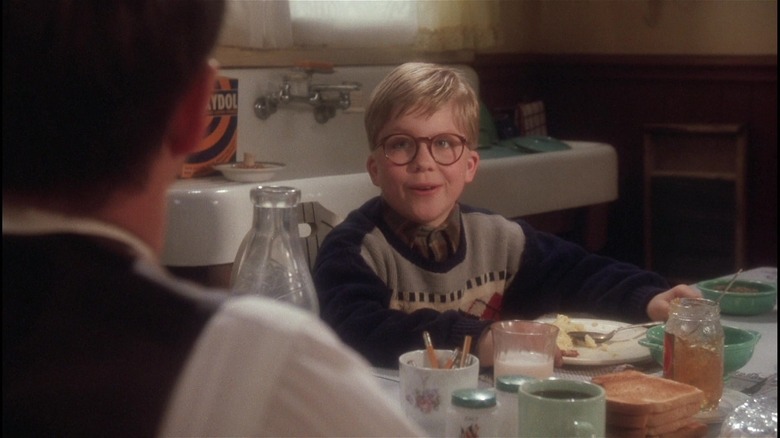The Key To Writing A Christmas Story Was Simplifying The Source Material
Few Christmas movies seem to be as frequently rewatched — and well-loved — as "A Christmas Story." Sure, "Home Alone" gives Ralphie a good run for his money, but it's hard to beat the annual 24-hour "A Christmas Story" marathons. Whether you always hunker down for the day-long ordeal or indulge your family by watching the classic movie once every few years (a situation that I can personally relate to — my dad's a big fan), "A Christmas Story" has certainly slipped its way into many people's holiday customs.
Of course, it certainly doesn't hurt that the movie is an ode to family, childhood innocence, and nostalgic traditions. If the holiday season tempts us to reminisce about simpler, happier days — when Christmas was met with pure, childlike excitement, the playground was the center of the universe, and hot chocolate tasted extra-sweet — "A Christmas Story" is an indulgence that chooses nostalgic realism over rose-tinted glasses. Ralphie's kid-sized troubles are a welcomed escape from real-world stresses, especially since a few years of work experience makes it hard to fully recall the sheer terror of his biggest problem: trying to secure a Red Ryder BB Gun on a kid's non-existent budget.
Given how real Ralphie's childhood feels, it's not much of a surprise that "A Christmas Story" claims to be based on true events (the film was an adaptation of several semi-autobiographical short stories by Jean Shepherd). That being said, its screenwriting team — Shepherd, Leigh Brown, and Bob Clark — still had their work cut out for them. According to Caseen Gaines' 2013 book, "A Christmas Story: Behind the Scenes of a Holiday Classic," the group's biggest task was "ton[ing] down [Shepherd's] second to none" vocabulary in order to make the movie as accessible as possible.
Adapting Shepherd's writing was tough
"A Christmas Story" might've enjoyed a childlike simplicity, but Jean Shepherd's written works were far more difficult to get through. The author-turned-screenwriter was aware of this, too. In the very first section of his vignette collection "In God We Trust: All Others Pay Cash," Shepherd describes reviewing a lengthy description of Hohman, Indiana and the surrounding area that he had written, then admits that he "[had] never been a fan of my particular style of Official Writer-ese, but, after all, it's a living."
The vivid descriptions and biting tone continue throughout the book. When recalling his childhood quest to find his mother the perfect Christmas gift, Shepherd makes the following (very un-childlike) comments:
"I had not yet made an irrevocable choice for my mother, but I had narrowed the field down to two spectacular items I had been stealthily eyeing at Woolworth's for several weeks. The first was a tasteful string of beads about the size of small walnuts, brilliant ruby in color with tiny yellow flowers embedded in the glass. The other and more expensive gift — $1.98 — was a pearl-colored perfume atomizer, urn-shaped, with golden lion's feet and matching gold top and squeeze bulb. It was not an easy choice. It was the age-old conflict between the Classic and the Sybaritic, and that is never easily resolved."
Shepherd's "Official Writer-ese" might've worked for the book, but could you really imagine little Ralphie saying that last line? 'Sybaritic' isn't exactly a staple of adult vocabulary; a kid using it on-screen would've thrown any nostalgic relatability out the window. "A Christmas Story" is so well-loved because we can see our younger selves in Ralphie, but most kids don't sound like Shepherd's prose. Simplifying the language was essential; it gave people a path into the holiday classic.
The story's origins are murky, but the movie remains magical
While Jean Shepherd undoubtedly had a knack for creating vivid descriptions, his talents may have also included coming up with fictional plotlines. The screenwriter was infamous for providing contradictory information about the origins of his stories. Although he would often claim that the written vignettes were based on his childhood, he also loved to flip the script and insist that "[N]one of these stories ... are based on any of my own memories." In other words, we can't necessarily trust his assertion that he had his own "BB gun incident."
Regardless of whether or not "A Christmas Story" (and its many sequels) were actually steeped in truth, the film's screenwriting team still did a great job of pulling together a variety of different threads from Shepherd's stories. And while it might've been tempting to spin the short stories into the wholesome fluff that Christmas movies are usually made of, Ralphie's constant problems lead to an infinitely more relatable movie. The smooth, idyllic happiness of a Hallmark movie makes for great escapism, but bumps along the road are closer to a real-life childhood. If you're going to reminisce, you may as well do it right — remembering the kid problems and all. After all, in comparison to the lows, the highs seem all the more sweet.


